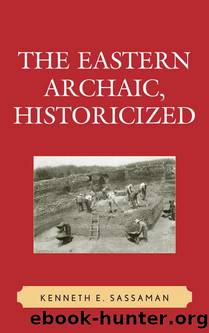The Eastern Archaic, Historicized by Sassaman Kenneth E.;

Author:Sassaman, Kenneth E.;
Language: eng
Format: epub
Publisher: AltaMira Press
Published: 2010-01-01T00:00:00+00:00
Native Trinkets?
In a recent synthesis of eastern North American prehistory, Milner (2004) sees the distribution of nonlocal items in the Middle and Late Archaic periods as the long-term consequence of commonplace, local practices.
Artifacts made from non-local materials were circulated for long periods as they were passed from one person to the next before ending up far from where they originated. . . . The people who ended up with items such as copper and marine shell would have been unaware of their origins. Even the most widely traveled people could have had only limited, and quite likely fanciful, knowledge about what lay beyond their direct experience or that of their elders and the members of neighboring groups. (Milner 2004, p. 43; italics mine)
In support of this generalization, Milner (2004, pp. 43â44) cites the case of Highland New Guinea people who, upon âfirstâ contact with Westerners, claimed they were unaware of the origins of the many seashells they possessed, or even that the sea existed. An incredible claim, indeed. Just as remarkable, I would suppose, as the claim that Yanamomö villagers made to Napoleon Chagnon (1977, p. 100) when he asked them why they did not make pottery while their neighbors did. Their answer was as follows: They did not know how to make pottery. They were thus dependent on their neighbors, they claimed, for acquiring pots. Remarkably, when hostilities broke out between these neighboring villages, and pottery acquisition became problematic, the nonpotting village started to make pots again. I would bet that some, perhaps all, of the Highland New Guinea people Milner cites actually knew a good deal about the sea and its shells.
These examples are offered as commentary not on the reliability of informant data but rather on the complex cultural values of objects of exchange. Milner characterizes exchange from a systems-serving perspective. Under increasing sedentism and greater potential for intergroup conflict, exchange between neighboring groups would have fostered cooperation and provided an economic buffer in lieu of settlement mobility. This is a familiar functionalist argument, consistent, in fact, with the explanation Chagnon (1977, pp. 100â101) proffers for the âamnesiaâ of nonpotting villagers. In this line of thinking, the motivation to establish, maintain, and manipulate alliances with other people supersedes any expressed cultural values about the objects themselves.
As far as systems-serving emergent properties are concerned, this logic holds its own. The trouble is, this logic cannot adequately account for the material patterns we have reviewed in this chapter. Indeed, down-the-line exchange of âtrinketsâ is hardly the only story, and certainly not the most interesting one from the perspective of actual practice. There is so much historical knowledge to be lost by treating objects of social interaction as mere tokens. Just as the objects of exchange in non-Western societies cannot be alienated from the biographies and genealogies of gifting them (e.g., Wallis 2009)âladen as they are with their own motivating logicâthe historical contexts of their production, distribution, and deposition are hardly inconsequential.
In emphasizing the phrase âwould have been unaware of
Download
This site does not store any files on its server. We only index and link to content provided by other sites. Please contact the content providers to delete copyright contents if any and email us, we'll remove relevant links or contents immediately.
Cecilia; Or, Memoirs of an Heiress — Volume 1 by Fanny Burney(31364)
Cecilia; Or, Memoirs of an Heiress — Volume 3 by Fanny Burney(30961)
Cecilia; Or, Memoirs of an Heiress — Volume 2 by Fanny Burney(30917)
The Great Music City by Andrea Baker(22063)
We're Going to Need More Wine by Gabrielle Union(18099)
Bombshells: Glamour Girls of a Lifetime by Sullivan Steve(13131)
Pimp by Iceberg Slim(12964)
All the Missing Girls by Megan Miranda(12795)
Fifty Shades Freed by E L James(12473)
Talking to Strangers by Malcolm Gladwell(11933)
Norse Mythology by Gaiman Neil(11929)
Crazy Rich Asians by Kevin Kwan(8385)
Mindhunter: Inside the FBI's Elite Serial Crime Unit by John E. Douglas & Mark Olshaker(7867)
The Lost Art of Listening by Michael P. Nichols(6499)
Enlightenment Now: The Case for Reason, Science, Humanism, and Progress by Steven Pinker(6428)
Bad Blood by John Carreyrou(5797)
The Four Agreements by Don Miguel Ruiz(5544)
Weapons of Math Destruction by Cathy O'Neil(5066)
We Need to Talk by Celeste Headlee(4895)
